Tom's Guide Verdict
The 2020 version of the 27-inch iMac looks the same, but has beefier specs, a better webcam and a great screen.
Pros
- +
Great display
- +
Rich-sounding speakers
- +
Powerful graphics and processor
Cons
- -
Thick bezels
- -
Ports all on back
Why you can trust Tom's Guide
The Apple iMac 27-inch (2020) couldn’t have come at a better time. Even as late as December, no one would have predicted that having a great webcam would be a necessity for all those Zoom calls we would be conducting in t-shirts and bathrobes. But here we are.
While the Apple iMac 27-inch looks identical to several previous generations, the insides have been upgraded with 10th generation Intel processors, AMD Radeon Pro 5000 series graphics, and perhaps most importantly, a 1080p webcam that will let your coworkers see your quarantine hair in all its glory.
But as we discovered during our Apple iMac 27-inch review, there are even more great features, such as the optional nano-texture glass and enhanced speakers, that make it one of the best all-in-one computers you can buy despite its high price. In fact, it's so good that it won a recommendation for best all-in-one PC in our Tom's Guide Awards 2021.
Editor's Note: On March 8th, 2022, Apple killed the 27-inch iMac.
Apple iMac 27-inch (2020): Specs
| Price | $1,799 | $1,999 | $2,299 |
|---|---|---|---|
| Processor (configurable up to 10th Gen Core i9) | 3.1GHz 10th-generation Intel Core i5 (6-core) | 3.3GHz 10th-generation Intel Core i5 (6-core) | 3.8GHz 10th-generation Intel Core i7 (8‑core) |
| RAM (configurable up to 128GB) | 8GB (two 4GB) of 2666MHz DDR4 memory | 8GB (two 4GB) of 2666MHz DDR4 memory | 8GB (two 4GB) of 2666MHz DDR4 memory |
| GPU | Radeon Pro 5300 (4GB of GDDR6 memory) | Radeon Pro 5300 (4GB of GDDR6 memory) | Radeon Pro 5500 XT (8GB of GDDR6 memory) |
| Display | 27-inch (diagonal) Retina 5K, 5120 x 2880 pixels | 27-inch (diagonal) Retina 5K, 5120 x 2880 pixels | 27-inch (diagonal) Retina 5K, 5120 x 2880 pixels |
| Webcam | 1080p FaceTime HD camera | 1080p FaceTime HD camera | 1080p FaceTime HD camera |
| Ports | 2x Thunderbolt 3, 4x USB-A, SDXC memory card reader, Gigabit Ethernet, headphone jack | 2x Thunderbolt 3, 4x USB-A, SDXC memory card reader, Gigabit Ethernet, headphone jack | 2x Thunderbolt 3, 4x USB-A, SDXC memory card reader, Gigabit Ethernet, headphone jack |
| Includes | Magic Keyboard, Magic Mouse 2, Lightning to USB cable | Magic Keyboard, Magic Mouse 2, Lightning to USB cable | Magic Keyboard, Magic Mouse 2, Lightning to USB cable |
| Connectivity | 802.11ac, IEEE 802.11a/b/g/n compatible, Bluetooth 5.0 | 802.11ac, IEEE 802.11a/b/g/n compatible, Bluetooth 5.0 | 802.11ac, IEEE 802.11a/b/g/n compatible, Bluetooth 5.0 |
Apple iMac 27-inch (2020): Price and availability
The Apple iMac 27-inch (2020) starts at $1,799, and includes 3.1GHz 6-core 10th-generation Intel Core i5 processor, an AMD Radeon Pro 5300 with 4GB of GDDR6 memory, 8GB of RAM, and a 256GB SSD.
The top-end preconfigured model costs $2,299, and has a 3.8GHz 8-core 10th-generation Intel Core i7 processor, AMD Radeon Pro 5500 XT with 8GB of GDDR6 memory, 8GB of RAM, and a 512GB SSD.
For the base model, the only customizable options include upping the RAM to 128GB of RAM and adding a 10 Gigabit Ethernet port.
Get instant access to breaking news, the hottest reviews, great deals and helpful tips.
On the mid-tier model ($1,999), you can upgrade the processor to a 3.6GHz 10-core 10th-generation Intel Core i9, and increase the hard drive size to 2TB. The top-end model gives you the option of a more powerful GPU (Radeon Pro 5700 XT with 16GB of GDDR6 memory) as well as up to 4TB of storage.
My review unit came equipped with a 3.6-GHz Intel Core i9 processor, 32GB of RAM, an AMD Radeon Pro 5700 XT GPU with 16 GB of VRAM, and a 1TB hard drive. Coupled with the nano-texture glass, this model goes for the princely sum of $4,499.
That’s $500 less than the starting price of an iMac Pro, which has a 3.0GHz 10-core Intel Xeon W processor, 32GB of RAM, a 1TB SSD, AMD Radeon Pro Vega 56 graphics with 8GB HBM2 memory, and a 10Gb Ethernet port.
On all three models, you have the option of adding the nano-texture glass, which adds $500 to the overall price.
Apple iMac 27-inch (2020): Design

Nothing new here, which is both good and bad. The 2020 iMac has the same sleek profile as the past eight years, but it also has the same chunky bezels and thick aluminum chin beneath. With a display as nice as the iMac’s, it would be nice if Apple would show it off more with as little bezel as possible. While HP’s Pavilion and Dell’s Inspiron all-in-ones don’t have as clean a look as the iMac, they do their best to shrink the bezel on their PCs.
The 2020 iMac has the same sleek profile, but it also has the same chunky bezels and thick aluminum chin beneath.
The iMac also has the same stand, a thin slip of aluminum that curves down from the back of the display. While it lets you tilt the screen back, you can’t change its height. If you need the screen to be higher, you’ll have to prop it up on something.
The iMac still measures 25.6 inches wide by 20.3 inches tall, and including the stand, has a depth of 8 inches. It weighs 19.7 pounds.
Apple iMac 27-inch (2020): Ports
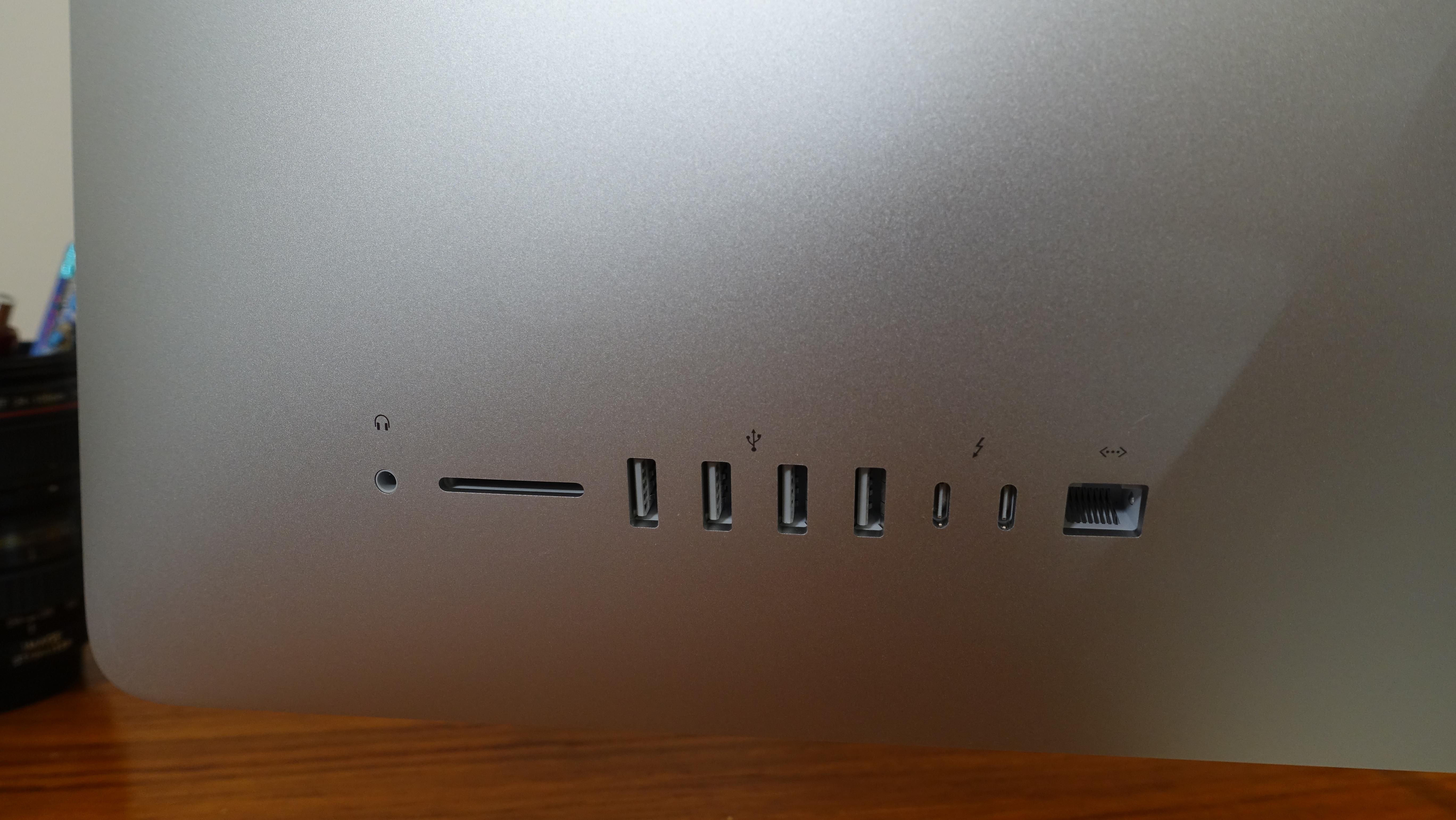
Nothing has changed since last year: The 2020 iMac sports two Thunderbolt 3 ports, four USB ports, an SDXC memory card reader, a Gigabit Ethernet port, and a headphone jack. As before, all the ports are on the rear of the system, which is great for its aesthetics, but a real pain when you want to slide in a memory card. Still, unlike Apple’s laptops, at least it has a memory card slot.
The iMac supports 802.11ac for Wi-Fi, and, in an upgrade from last year’s model, also supports Bluetooth 5.0.
Apple iMac 27-inch (2020): Display
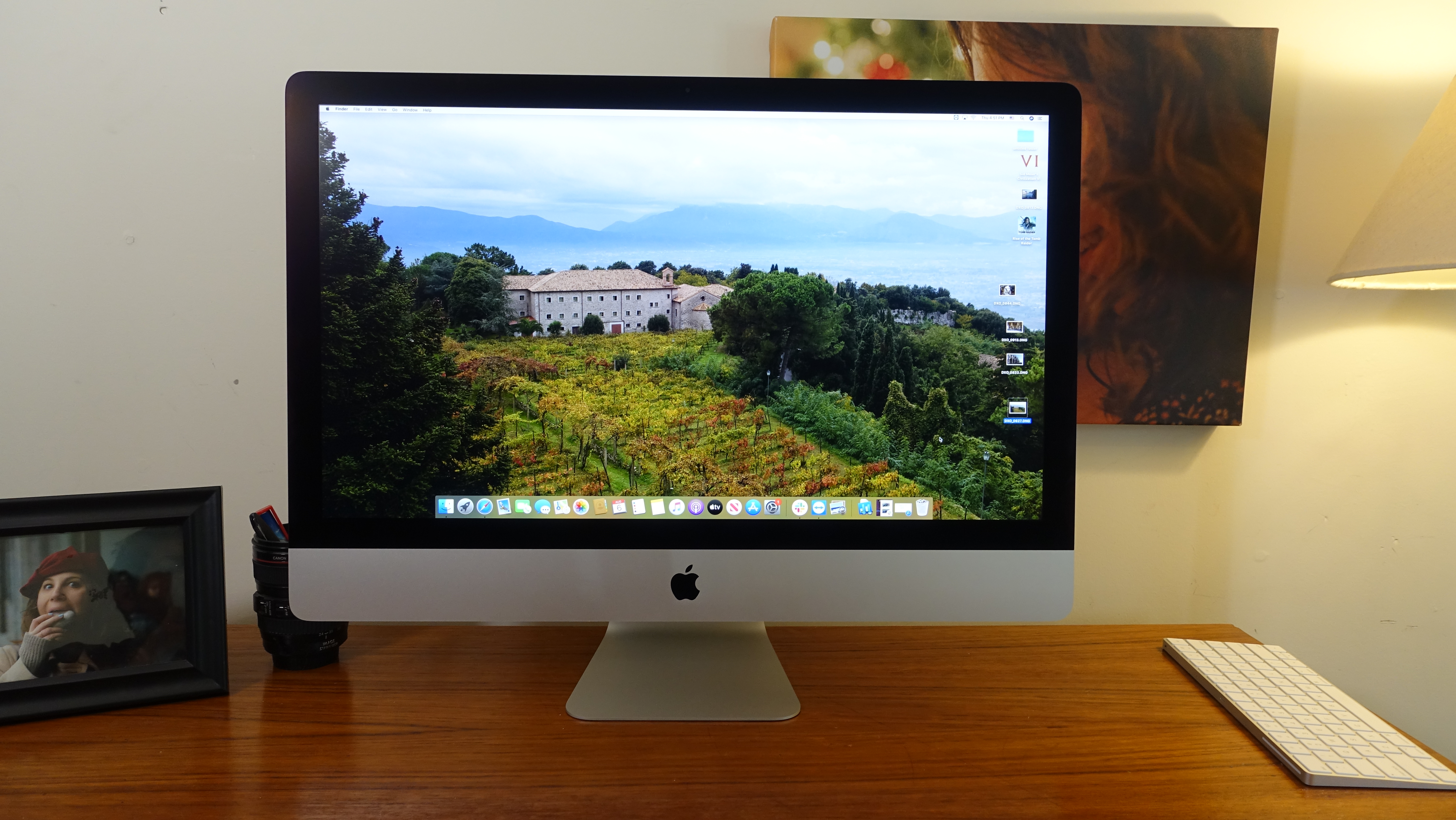
While the 2020 iMac has the same resolution and screen size as its predecessor (27 inches, 5120 x 2880 pixels and support for the P3 wide color space), it has a few new tricks to improve its viewability.
The biggest is the nano-texture option, which debuted on the Apple Pro Display XDR. This coating reduces glare, making it easier to see the screen when there’s a lot of ambient light.
For anyone who’s had to deal with screen glare, the nano-texture option will be worth the $500 investment. Remarkably, this option isn’t currently available for Apple’s iMac Pro, so video and photo professionals will be a bit torn on which model to get.
I held lights up right next to the screen, and aside from one small area closest to the light, the rest of the display remained free from reflections or glare. It also makes viewing angles excellent; you could easily fit a family of three or four around the screen to watch a movie without anyone complaining—about the image quality, at least.
I watched bits from a few movies, including Ford vs. Ferrari, 1917, and a number of trailers, and was impressed with not only the crispness, but the color fidelity and contrast of everything I saw.
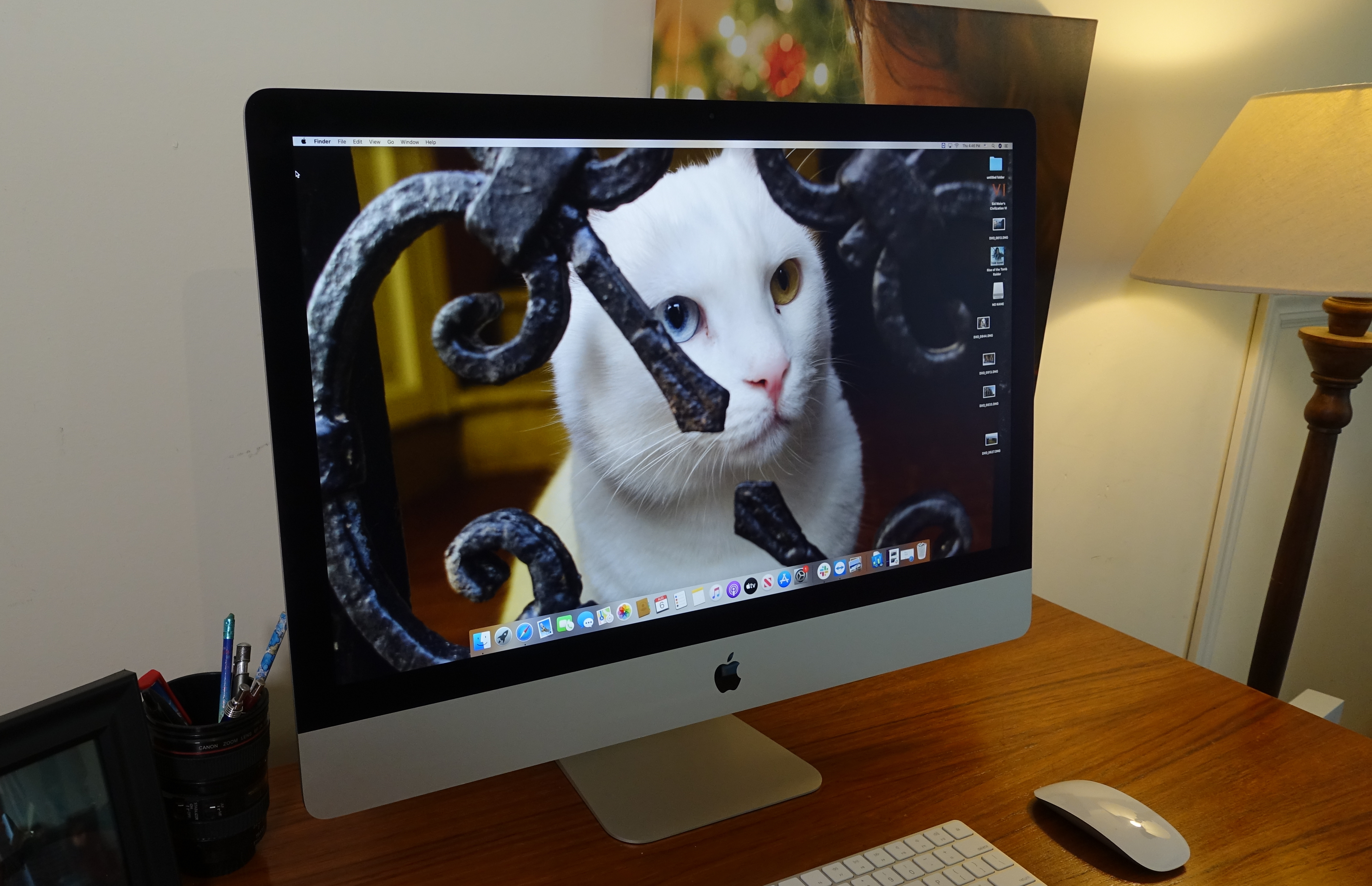
The other big feature on the iMac’s display is TrueTone support. Already available on the iPhone and MacBooks and iPads, TrueTone will change the display’s color temperature based on ambient light conditions. You can enable or disable this feature in the Control Panel, so those editing photos or video can get a more accurate depiction of what their images will look like.
My home office is lit by a few floor lamps and a little light from a window; activating TrueTone gave the screen a much warmer tone. When more or less light would stream in through the window, the tone would change noticeably, which can be a little distracting at times.
In a similar vein, you can also enable Night Shift, which will automatically adjust the screen colors to more warmer tones in the evening.
And no, it’s not a touchscreen.
Apple iMac 27-inch (2020): Audio
The 2020 iMac has the same speakers as its predecessor, but thanks to a new T2 chip, you can expect higher fidelity and deeper bass. I didn’t have last year’s iMac to compare, but I was impressed with what came out of the 2020 model.
I could really feel the deep grumble and whine of V8s and V12’s racing around LeMans in Ford vs. Ferrari. I was so immersed in the movie that my wife had to come and tell me to turn the volume down, for fear of waking our daughter.
Apple iMac 27-inch (2020): Webcam

Still can’t buy one of the best webcams? You won’t need an external camera with this iMac.. Boasting the same 1080p camera module as the iMac Pro, the iMac’s webcam also supports tone mapping, exposure control, and face detection. While it lacks Face ID, it can recognize your mug, and automatically apply adjustments so that you’re seen in the best light, so to speak.
Using Photo Booth I moved around the frame, and could definitely see the software at work; the whiteness of the background would shift from a reddish to a more white hue. However, it tinted my skin red, no matter where I sat. And, for a 1080p camera, I was a bit disappointed that details in my face weren’t sharper. Viewed at full size, my beard looked a bit mottled, and it was hard to pick out individual hairs.
I also used QuickTime to record myself; skin tones were much more true to life, and the background was also pretty accurate, too.
In addition, the iMac has three mics — two in the chin, and a third in the rear to help cancel out ambient noise. It works to an extent. My home office — which is also my attic — has a house fan that we use to keep cool. From where I was sitting, I recorded a noise level of about 52 decibels; on the recording, the iMac was able to minimize it pretty effectively.
Apple iMac 27-inch (2020): Performance

There seemed to be no task too big for the 3.6 GHz Intel Core i9-10910 CPU and 32GB of RAM in our review unit. Needless to say, you can open as many tabs in Chrome as you’d like and not have to worry about a performance hit.
To try and push the iMac to its limits, I opened 40 tabs in Chrome; the CPU hit was barely seven percent. I then fired up a few rounds of World of Tanks and blasted away at its highest settings without any impact. It was only when I used Handbrake to re-encode a video that the CPU was put to the test, but I still had plenty of power to spare.
Using the BlackMagic Disk Speed synthetic benchmark, the iMac’s 1TB SSD notched an average write speed of 2757 MBps and a read speed of 2467 MBps. That blows away not just last year’s iMac (1909MBps write/2,545 MBps read), but the iMac Pro (2,544MBps write), and left the Surface Studio 2 (815 MBps) and the Dell XPS 27 (1,208 MBps) in the dust.
On the Geekbench 5 CPU test, the iMac scored 1,300 on the single core test, and 9,843 on the multi-core test. To put that power in perspective, that multicore score beats out the 7,250 we got from our Core i9-powered MacBook Pro 16-inch.
Apple iMac 27-inch (2020): Graphics and gaming
Macs aren’t the go-to platform when it comes to gaming, but thanks to its Radeon Pro 5700 XT GPU and 16 GB of VRAM, the iMac is more than capable. On the Rise of the Tomb Raider benchmark (1080p, Very High settings), the iMac averaged 52.3 fps, edging past the Surface Studio 2’s score of 51 fps. On the Civilization IV benchmark, the iMac averaged 46.3 fps at 2560 x 1440, also a more than respectable score.
Apple is positioning the iMac as the desktop to get for amateur and semi-professionals, and our testing so far seems to back that up. We’re still running some other benchmarks, but the iMac was able to convert a 12-minute 4K video to 1080p in 5 minutes and 39 seconds using Handbrake. That’s notably faster than the 8 minutes we saw from the MacBook Pro 16-inch, which came powered with a Radeon 5500M GPU.
To really tax the system, I used Final Cut Pro X and applied the Aged Film filter to a two-hour and 30-minute 1080p video, and then timed how long it took to render. 33 minutes later, the rendering was complete. That’s an impressive render time, according to our head of video production.
Apple iMac 27-inch (2020): Keyboard and mouse
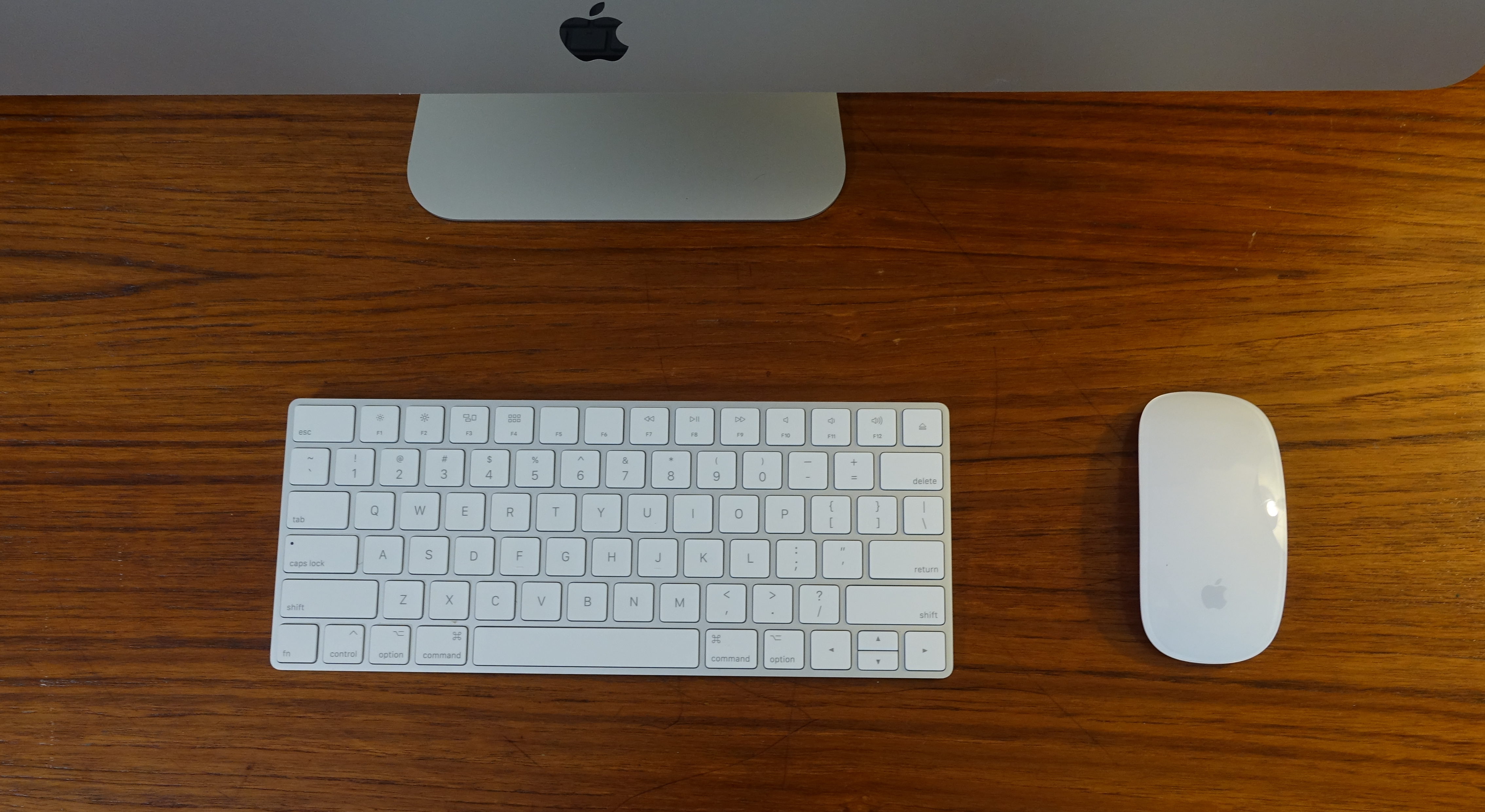
Maybe it’s because I’ve been using a Logitech G513 gaming keyboard and a Cooler Master MM830 gaming mouse for so long, but I found Apple’s minimalist keyboard and Magic Mouse to be very unsatisfying to use. They both look very sleek, but the low profile of the mouse, and the very slight travel of the keyboard made me long for my traditional keyboard and mouse quickly.
Still, after a short time, I was able to type fairly fast on the keyboard. Though it felt insubstantial in my hands, the mouse was responsive to my movements, as well as clicking and scrolling. And, they’re included as part of the package.
Apple iMac 27-inch (2020) review: Verdict
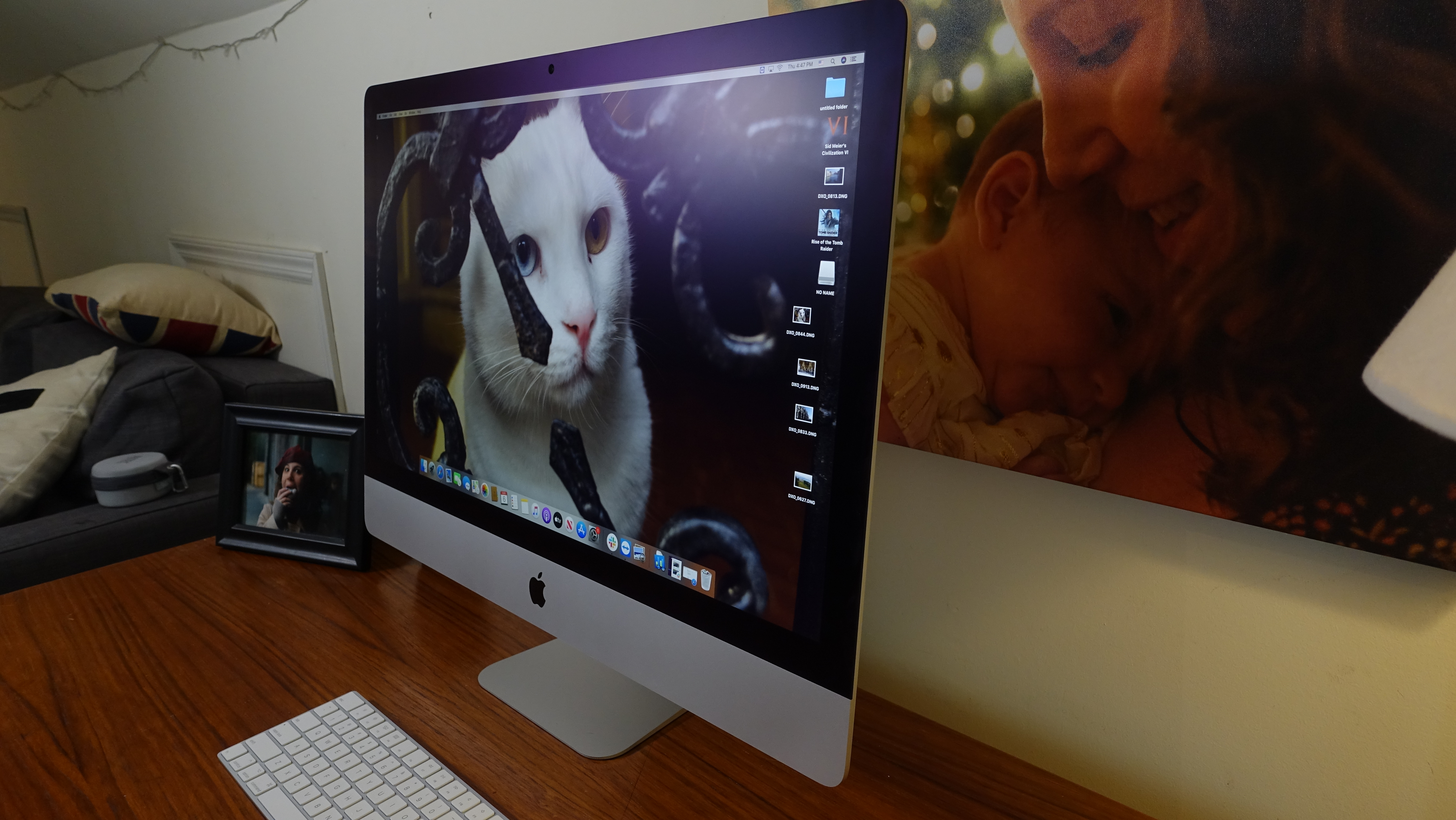
It’s more than likely that the 2020 iMac will be one of the last of Apple’s all-in-ones to run an Intel processor. If that’s the case, then Apple’s ARM chips have their work cut out for them. This machine — at least, the $4,500 model I tested — has some serious power, and a seriously gorgeous display. As with most Macs, it has a serious price to match, too.
The most comparable Windows model to our review unit is the Microsoft Surface Studio 2, which has a 28-inch 4500 x 3000-pixel display that can also display the P3 color gamut. The $4,199 configuration includes an Intel Core i7-7820HQ processor, 32GB of RAM, Nvidia GeForce GTX 1070 graphics, 8GB of video memory, and a 1TB SSD.
Closer to the iMac’s starting price is the HP Envy all-in-one (32-a1055) which costs $2,299, and has a 32-inch 4K display, 2.9GHz Intel Core i7-10700 processor, NVIDIA GeForce RTX 2070 , 16GB of RAM, a 512GB SSD and a 1TB, 7200rpm hard drive. Neither of those machines have the display resolution or quality of the iMac, though.
When the quarantine started, I was glad to have a nice big 27-inch Apple Cinema Display to which I could hook up my work MacBook Pro, so I wasn’t scrunched over a small screen in my home office. Given that we’ll be working from home at least through the end of 2020, investing in a capable desktop, as opposed to a laptop, seems like a smart idea. You get a lot more performance for the dollar, not to mention a lot more screen. So sit back and enjoy the iMac’s gorgeous 27-inch display.

Michael A. Prospero is the U.S. Editor-in-Chief for Tom’s Guide. He oversees all evergreen content and oversees the Homes, Smart Home, and Fitness/Wearables categories for the site. In his spare time, he also tests out the latest drones, electric scooters, and smart home gadgets, such as video doorbells. Before his tenure at Tom's Guide, he was the Reviews Editor for Laptop Magazine, a reporter at Fast Company, the Times of Trenton, and, many eons back, an intern at George magazine. He received his undergraduate degree from Boston College, where he worked on the campus newspaper The Heights, and then attended the Columbia University school of Journalism. When he’s not testing out the latest running watch, electric scooter, or skiing or training for a marathon, he’s probably using the latest sous vide machine, smoker, or pizza oven, to the delight — or chagrin — of his family.


